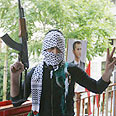
Hezbollah supporter, Lebanon
צילום: רויטרס
The new Lebanon battlefield
Israelis don’t fully realize scope of military threat posed by Hezbollah
Part 1 of article
Nobody knows whether a war will break out in Lebanon this summer. Yet what is completely clear is that a war in the north – if and when such war breaks out – will not be like the war that took place there in 2006. Hezbollah is growing stronger every day, in terms of the number of fighters, quantity of missiles, and capabilities. And what’s even more significant: The way this military power will be utilized will be vitally different.
Every few weeks, another piece of information finds its way to the media and hints to the new face of the confrontation taking shape in Lebanon. Both sides prepare for the next round in full force, yet the lay citizen doesn’t understand much of it. Well, another rocket was smuggled to Hezbollah, but it already has 40,000 anyway, so what’s the difference, people say. All the rockets are the same, the average Israeli thinks.
Meanwhile, our defense establishment does not bother to inform the public about the kind of confrontation it should be preparing for. Israeli citizens had already been stunned by the scope of the damage that the other side can cause and rightfully asked: How come we didn’t know? How come we didn’t prepare? And who’s responsible for this failure? Yet this is precisely what’s happening now too.
Defense officials and academic experts see a very clear picture of the new battlefield in Lebanon, but the average citizen, who will be a full party to the fighting in the next war, has no idea. Nobody tells him anything.
Coincidently, a foreign professional newspaper recently published an item about the M-600 missiles supplied by Syria to Hezbollah. Yet someone in Israel finds it convenient to hide this information, just like the transfer of Scud missiles to Lebanon was a secret in Israel, until it was uncovered by an Arab newspaper. Here and there, someone hints something about tensions on the northern border. Occasionally, Arab media report about unusual Air Force over-flights. Yet for the average Israeli all this activity is out of bounds, on the order of authorities.
So why didn’t Israel prevent the transfer of missiles and rockets into Lebanon? That’s a good question. We may get the answer for it in the history books to be written in the future.
Terrorizing civilians
It’s important that we understand that M-600 missiles in Hezbollah’s possession are not just another item in its arsenal. That’s the DNA; the code that exposes the new pattern of the group’s preparation for the next confrontation.
Let’s start from the fact that the M-600 is not a rocket, but rather, a much more accurate and effective weapon with strategic capabilities in Mideastern terms. Theoretically, Hezbollah would be able to hit the IDF headquarters in central Tel Aviv in the next war should it wish to do so. In 2006, it did not possess this ability.
Does it mean that what we saw in the Second Lebanon War – hundreds of short and medium range rockets fired at northern Israel every day – will not repeat? Not at all. Most of Hezbollah’s 40,000 rockets are still of this type, and next time it will again use them in an effort to sow destruction in northern communities and hit IDF troops before they enter Lebanon.
Based on the last war’s experience, these rockets are a “statistical weapon”: The fire is inaccurate, most rockets land in unpopulated areas, and the number of casualties and extent of damage isn’t great. However, in the next war, and in addition to the barrages we know, Hezbollah will have the option of firing dozens of accurate missiles simultaneously from dozens of launch sites across Lebanon – while directing them at one specific target.
Not only will the damage caused by these missiles be much more accurate and graver, it’s much more complicated to spot and destroy dozens of single missiles that will appear simultaneously at different sites.
The accurate missiles possessed by Hezbollah are meant to destroy strategic targets in central Israel. Such missiles are already deployed in southern Lebanon, with Hezbollah apparently intending to fire dozens of missiles daily for many days. At the same time, the group plans to fire thousands of other rockets, and through this combined attack destroy national infrastructure and various facilities.
The objective of the thousands of long-range missiles accumulated by Hezbollah would be to sow pure terror among civilians and undermine our willingness to fight. However, at this time, according to Hezbollah too, the group still does not possess enough accurate missiles in order to put this doctrine into action. This is precisely the junction that calls for much more intensive international and Israeli activity, in order to curb the flow of accurate arms into Lebanon, before it’s too late.
Part 2 of article to be published Saturday










